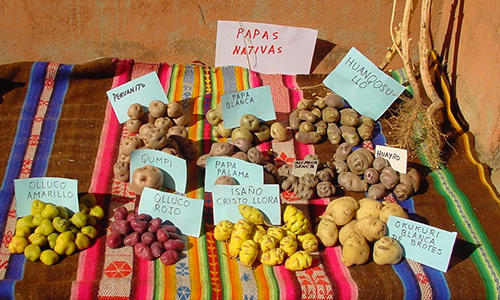Noah’s Ark on a budget: How to decide which diversity to safeguard?

In a recent paper, Bioversity International researchers show how a mathematically rigorous approach can help policymakers make decisions about what crop diversity to conserve in the most cost-effective way.
How can a busy policymaker with a limited budget make decisions about what crop diversity to conserve in the most cost-effective way? Or, as Noah might have put it: “Which species should we take on board the Ark?” There are 7,000 edible species in the world, of which one in seven is under threat. Not all can be saved, so policymakers have to decide where to focus the resources available for conservation. This is the challenge taken up by Bioversity International researchers Aurelia Samuel, Adam Drucker and Maarten van Zonneveld, together with colleagues from the University of Copenhagen and the Georg-August University, in a paper recently published in Ecological Economics.
The researchers took a mathematically rigorous approach that has been successfully used to prioritize the conservation of animals – the Weitzman approach – to see if they could use it for plants. By combining measures of diversity, current risk status and conservation costs, this approach facilitates the identification of a priority conservation portfolio by focusing attention on the set of species and varieties that permit a maximum amount of diversity to be conserved for any given budget.
The authors of the study decided to test the Weitzman approach, in the first instance, on cacao, not only because cacao diversity has been well-documented and we know it is subject to genetic erosion, but also because it is a crop that is important to smallholder farmers. Ideally, each variety of cacao would be considered independently, but that would require computing power far beyond even what is possible today. So the researchers decided to consider families, or ‘clusters’, of cacao varieties, building on molecular markers previously identified by others. The application of the Weitzman approach to cacao clearly showed that some clusters warrant higher priority within conservation funding strategies because they are both very distinct and at high risk, while others can be assigned a lower priority.
For policymakers facing tough budget allocations, this case study shows that the Weitzman approach has potential as a decision-support tool for plant genetic resource conservation. Although some subjective, context-specific decisions have to be made before using the tool, such as the kind of diversity we want to conserve (e.g. varieties or alleles) and the most relevant risk measures for the crop or tree genetic resource in question (e.g. inbreeding or climate change), once these decisions have been made, the tool can help policymakers take better informed conservation strategy decisions.
The paper is available here
